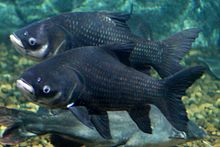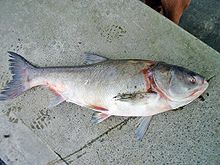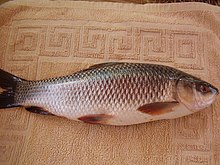|
Cyprinidae
Cyprinidae is a family of freshwater fish commonly called the carp or minnow family, including the carps, the true minnows, and their relatives the barbs and barbels, among others. Cyprinidae is the largest and most diverse fish family, and the largest vertebrate animal family overall, with about 3,000 species; only 1,270 of these remain extant, divided into about 200 valid genera.[2][3] Cyprinids range from about 12 mm (0.5 in) in size to the 3 m (9.8 ft) giant barb (Catlocarpio siamensis).[4] By genus and species count, the family makes up more than two-thirds of the ostariophysian order Cypriniformes.[2][3][5] The family name is derived from the Greek word kyprînos (κυπρῖνος 'carp'). Biology and ecologyCyprinids are stomachless, or agastric, fish with toothless jaws. Even so, food can be effectively chewed by the gill rakers of the specialized last gill bow. These pharyngeal teeth allow the fish to make chewing motions against a chewing plate formed by a bony process of the skull. The pharyngeal teeth are unique to each species and are used to identify species. Strong pharyngeal teeth allow fish such as the common carp and ide to eat hard baits such as snails and bivalves. Hearing is a well-developed sense in the cyprinids since they have the Weberian organ, three specialized vertebral processes that transfer motion of the gas bladder to the inner ear. The vertebral processes of the Weberian organ also permit a cyprinid to detect changes in motion of the gas bladder due to atmospheric conditions or depth changes. The cyprinids are considered physostomes because the pneumatic duct is retained in adult stages and the fish are able to gulp air to fill the gas bladder, or they can dispose of excess gas to the gut.  Cyprinids are native to North America, Africa, and Eurasia. The largest known cyprinid is the giant barb (Catlocarpio siamensis), which may grow up to 3 m (9.8 ft) in length and 300 kg (660 lb) in weight.[4] Other very large species that can surpass 2 m (6.6 ft) are the golden mahseer (Tor putitora) and mangar (Luciobarbus esocinus).[6][7] The largest North American species is the Colorado pikeminnow (Ptychocheilus lucius), which can reach up to 1.8 m (5.9 ft) in length.[8] Conversely, many species are smaller than 5 cm (2 in). The smallest known fish is Paedocypris progenetica, reaching 10.3 mm (0.41 in) at the longest.[9] All fish in this family are egg-layers and most do not guard their eggs; however, a few species build nests and/or guard the eggs. The bitterlings of subfamily Acheilognathinae are notable for depositing their eggs in bivalve molluscs, where the young develop until able to fend for themselves. Cyprinids contain the first and only known example of androgenesis in a vertebrate, in the Squalius alburnoides allopolyploid complex.[10] Most cyprinids feed mainly on invertebrates and vegetation, probably due to the lack of teeth and stomach; however, some species, like the asp, are predators that specialize in fish. Many species, such as the ide and the common rudd, prey on small fish when individuals become large enough. Even small species, such as the moderlieschen, are opportunistic predators that will eat larvae of the common frog in artificial circumstances. Some cyprinids, such as the grass carp, are specialized herbivores; others, such as the common nase, eat algae and biofilms, while others, such as the black carp, specialize in snails, and some, such as the silver carp, are specialized filter feeders. For this reason, cyprinids are often introduced as a management tool to control various factors in the aquatic environment, such as aquatic vegetation and diseases transmitted by snails. Unlike most fish species, cyprinids generally increase in abundance in eutrophic lakes. Here, they contribute towards positive feedback as they are efficient at eating the zooplankton that would otherwise graze on the algae, reducing its abundance. Relationship with humans
 Wild capture of cyprinids by species in million tonnes, 1950–2009, as reported by the FAO[11] FoodCyprinids are highly important food fish; they are fished and farmed across Eurasia. In land-locked countries in particular, cyprinids are often the major species of fish eaten because they make the largest part of biomass in most water types except for fast-flowing rivers. In Eastern Europe, they are often prepared with traditional methods such as drying and salting. The prevalence of inexpensive frozen fish products made this less important now than it was in earlier times. Nonetheless, in certain places, they remain popular for food, as well as recreational fishing, for ornamental use, and have been deliberately stocked in ponds and lakes for centuries for this reason.[12] SportCyprinids are popular for angling especially for match fishing (due to their dominance in biomass and numbers) and fishing for common carp because of its size and strength. As pest controlSeveral cyprinids have been introduced to waters outside their natural ranges to provide food, sport, or biological control for some pest species. The common carp (Cyprinus carpio) and the grass carp (Ctenopharyngodon idella) are the most important of these, for example in Florida. As a pest speciesCarp in particular can stir up sediment, reducing the clarity of the water and making plant growth difficult.[13][14] In America and Australia, such as the Asian carp in the Mississippi Basin, they have become invasive species that compete with native fishes or disrupt the environment. Cyprinus carpio is a major pest species in Australia impacting freshwater environments, amenity, and the agricultural economy, devastating biodiversity by decimating native fish populations where they first became established as a major pest in the wild in the 1960s. In the major river system of eastern Australia, the Murray-Darling Basin, they constitute 80–90 per cent of fish biomass.[15] In 2016 the federal government announced A$15.2 million to fund the National Carp Control Plan to investigate using Cyprinid herpesvirus 3 (carp virus) as a biological control agent while minimising impacts on industry and environment should a carp virus release go ahead. Despite initial, favourable assessment,[16][17][18] in 2020 this plan was found to be unlikely to work due to the high fecundity of the fish.[19] Aquarium fishNumerous cyprinids have become popular and important within the aquarium and fishpond hobbies, most famously the goldfish, which was bred in China from the Prussian carp (Carassius (auratus) gibelio). First imported into Europe around 1728, it was originally much-fancied by the Chinese nobility as early as 1150 AD and, after it arrived there in 1502, also in Japan. In addition to the goldfish, the common carp was bred in Japan into the colorful ornamental variety known as koi — or more accurately nishikigoi (錦鯉), as koi (鯉) simply means "common carp" in Japanese — from the 18th century until today. Other popular aquarium cyprinids include danionins, rasborines and true barbs.[20] Larger species are bred by the thousands in outdoor ponds, particularly in Southeast Asia, and trade in these aquarium fishes is of considerable commercial importance. The small rasborines and danionines are perhaps only rivalled by characids (tetras) and poecilid livebearers in their popularity for community aquaria.[citation needed] Some of the most popular cyprinids among aquarists, other than goldfish and koi, include the cherry barb, Harlequin rasbora, pearl danios, rainbow sharks, tiger barbs, and the White Cloud Mountain minnow. One particular species of these small and undemanding danionines is the zebrafish (Danio rerio). It has become the standard model species for studying developmental genetics of vertebrates, in particular fish.[21] Threatened familiesHabitat destruction and other causes have reduced the wild stocks of several cyprinids to dangerously low levels; some are already entirely extinct. In particular, the cyprinids of the subfamily Leuciscinae from southwestern North America have been severely affected by pollution and unsustainable water use in the early to mid-20th century. The majority of globally extinct cypriniform species in fact belong to the leuciscinid cyprinids from the southwestern United States and northern Mexico. SystematicsThe massive diversity of cyprinids has so far made it difficult to resolve their phylogeny in sufficient detail to make assignment to subfamilies more than tentative in many cases. Some distinct lineages obviously exist – for example, the Cultrinae and Leuciscinae, regardless of their exact delimitation, are rather close relatives and stand apart from Cyprininae – but the overall systematics and taxonomy of the Cyprinidae remain a subject of considerable debate. A large number of genera are incertae sedis, too equivocal in their traits and/or too little-studied to permit assignment to a particular subfamily with any certainty.[22][23][24] Part of the solution seems that the delicate rasborines are the core group, consisting of minor lineages that have not shifted far from their evolutionary niche, or have coevolved for millions of years. These are among the most basal lineages of living cyprinids. Other "rasborines" are apparently distributed across the diverse lineages of the family.[23] The validity and circumscription of proposed subfamilies like the Labeoninae or Squaliobarbinae also remain doubtful, although the latter do appear to correspond to a distinct lineage. The sometimes-seen grouping of the large-headed carps (Hypophthalmichthyinae) with Xenocypris, though, seems quite in error. More likely, the latter are part of the Cultrinae.[23] The entirely paraphyletic "Barbinae" and the disputed Labeoninae might be better treated as part of the Cyprininae, forming a close-knit group whose internal relationships are still little known. The small African "barbs" do not belong in Barbus sensu stricto – indeed, they are as distant from the typical barbels and the typical carps (Cyprinus) as these are from Garra (which is placed in the Labeoninae by most who accept the latter as distinct) and thus might form another as yet unnamed subfamily. However, as noted above, how various minor lineages tie into this has not yet been resolved; therefore, such a radical move, though reasonable, is probably premature.[22][25] The tench (Tinca tinca), a significant food species farmed in western Eurasia in large numbers, is unusual. It is most often grouped with the Leuciscinae, but even when these were rather loosely circumscribed, it always stood apart. A cladistic analysis of DNA sequence data of the S7 ribosomal protein intron 1 supports the view that it is distinct enough to constitute a monotypic subfamily. It also suggests it may be closer to the small East Asian Aphyocypris, Hemigrammocypris, and Yaoshanicus. They would have diverged roughly at the same time from cyprinids of east-central Asia, perhaps as a result of the Alpide orogeny that vastly changed the topography of that region in the late Paleogene, when their divergence presumably occurred.[24] A DNA-based analysis of these fish places the Rasborinae as the basal lineage with the Cyprininae as a sister clade to the Leuciscinae.[26] The subfamilies Acheilognathinae, Gobioninae, and Leuciscinae are monophyletic. Subfamilies and genera       Eschmeyer's Catalog of Fishes sets out the subfamilies and genera within the family Cyprinidae as follows:[27][1][28] With such a large and diverse family the taxonomy and phylogenies are always being worked on so alternative classifications are being created as new information is discovered, for example:[29] Phylogeny
See alsoReferences
External links
|
||||||||||||||||||||||||||||||||

